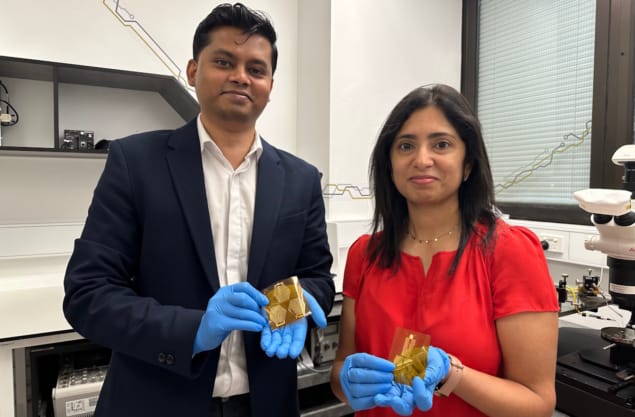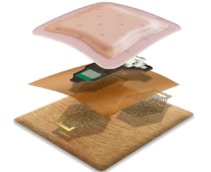
Conventional electrocardiograms (ECG) often require bulky, heavy devices, such as the 12-lead ECG you see at a hospital bedside. Patients are connected to equipment by wires, and they must lay still while the electrical signals of their heart are monitored.
As such, conventional ECGs don’t work well for monitoring the heart’s electrical activity during daily activities, such as working in your garden, taking a shower or cooking a meal.
For Peter Elango, continuous ECG monitoring is the goal. Elango, a PhD candidate working in Madhu Bhaskaran’s research group at RMIT University in Melbourne, and his colleagues have prototyped a wearable ECG device. Described in Applied Physics Reviews, the device may save lives and reduce healthcare costs while enhancing point-of-care diagnostics.
“This research started as a ‘what if’ – what if you could miniaturize the hospital [ECG] setup, and what if you could make it more compact and versatile?” Elango says.
The result is a lightweight, hexagonal-shaped patch consisting of three dry electrodes, each less than one tenth of the width of a human hair. Unlike the “wet” Ag/AgCl electrodes typically used in devices that measure ECG signals, dry electrodes don’t use a conductive gel to enhance electrical signalling. As a result, they are more comfortable and may result in less skin irritation.

Elango compares the ECG patch to a band-aid. “You peel it, just put it on, and you don’t feel it because it’s around 10 grams, it’s almost featherweight. It can be on the chest region or the neck region; you’re not even going to feel it,” he says.
The researchers optimized the patch design and electrode placement to conform to the skin and move with a patient’s body throughout the day, ensuring that cardiac signals are collected continuously. The patch is integrated with wireless Bluetooth communication for signal transmission and processing. And each electrode is gold, a material that Elango says will be reclaimed and recycled after a patient is done using the ECG patch.
“What’s fascinating is not only can the user be aware of their day-to-day cardiac activity, the medical personnel, the family members could access it, which is particularly important if a person is just admitted and released from the hospital and they need constant care and monitoring,” Elango explains.
The gold standard for monitoring the heart’s electrical signals is still a 12-lead ECG. Elango says that their device will be an indicator for patients to go and see a medical practitioner.

Ultrathin e-tattoo provides continuous heart monitoring
“The future of wearable sensors is imminent – even a few years ago, our watches couldn’t make phone calls, for example, and now they can. This work could potentially revolutionize how we monitor cardiac health,” he adds.
The researchers have patented their device and are looking to license it with a company before proceeding with clinical trials. They’ll also be fine-tuning electrode parameters and signal processing.
- SEO Powered Content & PR Distribution. Get Amplified Today.
- PlatoData.Network Vertical Generative Ai. Empower Yourself. Access Here.
- PlatoAiStream. Web3 Intelligence. Knowledge Amplified. Access Here.
- PlatoESG. Carbon, CleanTech, Energy, Environment, Solar, Waste Management. Access Here.
- PlatoHealth. Biotech and Clinical Trials Intelligence. Access Here.
- Source: https://physicsworld.com/a/wearable-ecg-provides-continuous-cardiac-monitoring/
- :is
- :not
- 10
- 160
- a
- access
- activities
- activity
- Adds
- admitted
- After
- ago
- aip
- almost
- also
- an
- and
- ARE
- around
- AS
- At
- austin
- aware
- band-aid
- BE
- because
- before
- bluetooth
- body
- by
- Calls
- CAN
- candidate
- care
- click
- Clinical
- clinical trials
- colleagues
- comfortable
- Communication
- compact
- company
- connected
- Consisting
- constant
- continuous
- continuously
- conventional
- Costs
- could
- daily
- Daniel
- day
- day-to-day
- described
- Design
- device
- Devices
- diagnostics
- done
- Dont
- dry
- during
- each
- enhance
- enhancing
- ensuring
- equipment
- Even
- example
- Explains
- family
- family members
- fascinating
- feel
- few
- For
- from
- future
- Garden
- Go
- goal
- going
- Gold
- Gold Standard
- Grams
- Group
- Hair
- Have
- he
- Health
- healthcare
- Heart
- heavy
- his
- holding
- hospital
- How
- HTTPS
- human
- if
- image
- imminent
- important
- in
- Including
- Indicator
- information
- integrated
- Inventors
- issue
- IT
- jpg
- just
- lay
- layers
- less
- License
- lightweight
- Lives
- looking
- make
- material
- max-width
- May..
- measure
- medical
- Melbourne
- Members
- Module
- Monitor
- monitored
- monitoring
- more
- move
- must
- Need
- now
- of
- often
- on
- ONE
- only
- open
- optimized
- or
- our
- parameters
- part
- particularly
- Patch
- patented
- patient
- patients
- person
- Personnel
- Peter
- phd
- phone
- phone calls
- Physics
- Physics World
- placement
- plato
- Plato Data Intelligence
- PlatoData
- potentially
- processing
- provides
- put
- recycled
- reduce
- region
- released
- require
- research
- researchers
- result
- revolutionize
- Save
- says
- see
- sensors
- setup
- Signal
- signals
- Skin
- standard
- started
- Still
- such
- taking
- texas
- than
- that
- The
- their
- they
- this
- three
- throughout
- thumbnail
- to
- trials
- true
- typically
- university
- unlike
- use
- used
- User
- using
- various
- versatile
- watches
- we
- wearable
- WELL
- What
- which
- while
- width
- will
- wireless
- with
- Work
- working
- world
- years
- You
- Your
- zephyrnet













